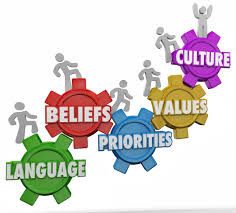Cultures and SubCultures
Mainstream culture refers to the cultural
patterns that are broadly in line with a society’s cultural ideals and values.
Within any society there are also subcultures which are cultural patterns that
set apart a segment of a society’s population. Cultural groups with the most
power and societal influence get labelled the norm, and people with less power
get relegated to sub-groups. The US is a great example since it is thought of
as a “melting pot”, a place where many cultures come together to form a single
combined culture. However, each subculture is unique, and they don´t
necessarily blend together into one big cohesive culture just because they
share a country. Also, some cultures are valued more than others in the US.
Multiculturalism is a perspective that rather
than seeing society as a homogenous culture, recognizing cultural diversity
while advocating for equal standing for all cultural traditions. The ways in
which cultures and subcultures fit together can vary, depending on your school
of thought as a sociologist:
STRUCTURAL FUNCTIONALIST:
believes cultures form to provide order and cohesiveness in a society.
CONFLICT THEORIST: considers that prioritizing one sub-culture
over another can create social inequalities and disenfranchise those who belong
to cultures that are at odds with the mainstream.
As borders get thinner the group of people who
share a culture gets larger. More and more overlap as technology and
globalization make our world a bit smaller. Who is right? Structural
Functionalists that believe that having a shared culture provide points of
similarity that encourage cooperation and help societies function? Or Conflict
Theorist that believe that culture divides us and benefits some members of
society more than others?
In all these essays I am supporting Conflict
Theory to explain how subcultures do not present similar levels of integration,
leading to the rise in inequality. This is very noticeable in Europe
today where communities that are not of european origin are not considered
european. Consider the following essay “Marketing and Consumer Studies Chapter
13 Ethnic, Racial and Religious SubCultures”, which is aimed at how to market
to different subcultures in the US: “Members of minority groups are more likely
to find an advertising spokesperson from their own group to be more
trustworthy, and this enhanced credibility in turn translates into more
positive brand attitudes. The way marketing messages should be structured
depends on subcultural differences in how meanings are communicated”. The study
considers ethnic, racial and religious subcultures, and how to communicate a
marketing message to each of them. Mexican-Americans, Cuban-Americans, African-Americans, Muslims, Jewish, are not
the same, which leads to segregation where immigrants (and their descendants)
are often likely to live and shop in places that are physically separated from
mainstream Anglo consumers. They
share values, religion, beliefs and influences that are important to consider
when conveying a marketing strategy to these different consumer groups.
Consider the following essay by Sune Qvotrup
Jensen “Rethinking subcultural capital”: “what we are witnessing in Denmark among a
number of underprivileged young men of non-Danish ethnic origin could now be
meaningfully understood and explained through an analysis guided by the concept
of subcultural capital, but only if this concept is rethought in a way that
allows us to analyze it in relation to the intersections between class, gender,
ethnicity and "race". I argue that the lack of recognition of these
young people is in fact related to a very high degree to their class, gender,
ethnicity and "race" and that a distinct form of subcultural capital
is an integral part of the "solution" to - or stylistic attempt
overcome this problem. In other words, subcultural capital is, at least in this
case, generalized and of a specific and at the same time class and
class-specific, racialized and ethnicized.”
Mr. Jensen clearly recognizes the existance of
subcultures of non-ethnic danes in Denmark, who are underpriviliged compared to
ethnic danes. As I explained in my chapter “The EuroCrisis, a Cultural
Crisis, Chapter 5: Capitalizing on Business Cultures”, these subcultures are
not being capitalized. They do not have the Cultural or Social Capital to
progress in society and achieve a condition of equally compared to the
mainstream culture that has inhabited the land for more generations. They do
not have the same level of inheritance either (check: Inheritance, the root of
inequality). These
communities live in the same country, have access to the same public
facilities, but still do not share the same standard of living. As these
communities grow, inequality grows as well. Contrary to the Socialist Utopias
belief, wealth does not cascade down in society equally. We will take back that
concept later.





No comments:
Post a Comment